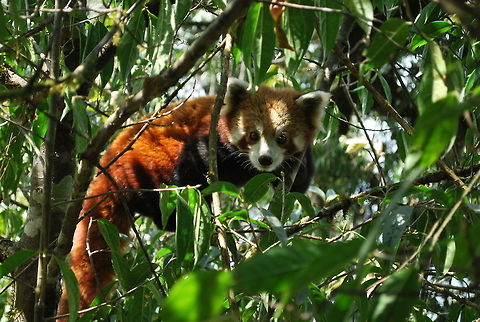
Appearance
The head and body length of red pandas averages 56 to 63 cm , and their tails about 37 to 47 cm . Males weigh 3.7 to 6.2 kg and females 4.2 to 6.0 kg . They have long, soft reddish-brown fur on the upper parts, blackish fur on the lower parts, and a light face with tear markings and robust cranial-dental features. The light face has white badges similar to those of a raccoon, but each individual can have distinctive markings. Their roundish head has medium-sized upright ears, a black nose, and very dark eyes: almost pitch black. Their long bushy tail with six alternating yellowish red transverse ochre rings provides balance and excellent camouflage against its habitat of moss- and lichen-covered trees. The legs are black and short with thick fur on the soles of the paws. This fur serves as thermal insulation on snow-covered or ice surfaces and conceals scent glands which are also present on the anus.The red panda is specialized as a bamboo feeder with strong, curved and sharp semi-retractile claws standing inward for grasping of narrow tree branches, leaves and fruit. Like the giant panda, it has a “false thumb” that is an extension of the wrist bone. When descending a tree headfirst, the red panda rotates its ankle to control its descent, one of the few climbing species to do so.

Naming
Distribution of the red panda is disjointed, and there are two extant subspecies:⤷ Western red panda ''Ailurus fulgens fulgens'' — lives in the western part of its range: in Nepal, Assam, Sikkim and Bhutan;
⤷ Styan's red panda ''Ailurus fulgens styani'' — lives in the east-northeastern part of its range: in southern China and northern Myanmar.
''Ailurus fulgens styani'' has been described by Thomas in 1902 based on one skull from a specimen collected in Szechwan....hieroglyph snipped... Pocock distinguished ''styani'' from ''fulgens'' by its longer winter coat and more abundant blackness in the pelage, bigger skull, more strongly curved forehead, and more robust teeth. His description is based on skulls and skins collected in Szechwan, Myitkyina close to the border of Yunnan, and Upper Burma.
The Styan's red panda is supposedly larger and darker in color than its Western cousin, but there is considerable variation in both subspecies, and some individuals may be brown or yellowish brown rather than red.
The Brahmaputra river is often considered the natural division between the two subspecies, where it makes a curve around the eastern end of the Himalayas. Although some authors suggest that ''A. f. fulgens'' extends farther eastward, into China.The red panda's local names differ from place to place. The Lepcha people call it ''sak nam''. In Nepal, the species is called ''bhalu biralo'' and ''habre''. The Sherpa people of Nepal and Sikkim call it ''ye niglva ponva'' and ''wah donka''. The word ''wậː'' is Sunuwari meaning ''bear''; in Tamang language, a small, red bear is called ''tāwām''. In the Kanchenjunga region of eastern Nepal, the Limbus know red pandas as ''Kaala'', which literally means dark because of their underside pelage; villagers of Tibetan origin call them ''Hoptongar''.
Additionally, Pocock lists the vernacular names ''Ye'' and ''Nigálya ponya'' ; ''Thokya'' and ''Thongwa'' ; ''Oakdonga'' or ''Wakdonka'' and ''Woker'' ; ''Saknam Sunam'' . ''Nigálya'' may originate from the Nepali word ''निङालो niṅālo'' or ''nĩgālo'' meaning a particular kind of small bamboo, namely Arundinaria intermedia, but also refers to a kind of small leopard, or cat-bear. The word ''pónya'' may originate from the Nepali word ''पञ्जा pajā'' meaning claw, or ''पौँजा paũjā'' meaning paw of an animal. ''Nigálya pónya'' may translate to 'bamboo claw' or 'bamboo paw'.
''Nigálya pónya'', ''nyala ponga'', and ''poonya'' are said to mean ''eater of bamboo''. It could be that the name ''panda'' originates from ''panjā''.
In English, the red panda is also called ''lesser panda'', though due to the pejorative implications of this name, "red" is generally preferred. Many other languages use red panda, or variations of shining/gold or lesser/small in their names for this species. For instance, ''червена панда'' in Bulgarian, ''panda roux'' in French, and ''panda rojo'' in Spanish all mean red panda. Since at least as far back as 1855, one of its French names has been ''panda éclatant'' . In Finnish, it is called ''kultapanda'' . Variations of ''lesser panda'' occur in French ''petit panda'' , in Spanish ''panda menor'' , in Dutch ''kleine panda'' , in Russian «малая панда» , in Korean 애기판다 , in Japanese ressā panda .
Other names attributed to this species include fire cat, bright panda and common panda.
In Chinese language, the red panda is called 小熊貓 , and ...snipped.../...snipped... .
The English name ''firefox'' is often claimed by English sources to be a literal translation of the Chinese name for the red panda. But the Chinese word ...snipped... huǒhú refers to the Firefox web browser.
The Giant Panda is called ...snipped.../...snipped... .

Distribution
The red panda is endemic to the temperate forests of the Himalayas, and ranges from the foothills of western Nepal to China in the east. Its easternmost limit is the Qinling Mountains of the Shaanxi Province in China. Its range includes southern Tibet, Sikkim and Assam in India, Bhutan, the northern mountains of Myanmar, and in southwestern China, in the Hengduan Mountains of Sichuan and the Gongshan Mountains in Yunnan. It may also live in southwest Tibet and northern Arunachal Pradesh, but this has not been documented. Locations with the highest density of red pandas include an area in the Himalayas that has been proposed as having been a refuge for a variety of endemic species in the Pleistocene. The distribution range of the red panda should be considered disjunct, rather than continuous. A disjunct population inhabits the Meghalaya Plateau of northeastern India.During a survey in the 1970s, signs of red pandas were found in Nepal's Dhorpatan Hunting Reserve. Their presence was confirmed in spring 2007 when four red pandas were sighted at elevations ranging from
3,220 to 3,610 m . The species' westernmost limit is in Rara National Park located farther west of the Dhorpatan Hunting Reserve. Their presence was confirmed in 2008.
The red panda lives between 2,200 and 4,800 meters altitude, inhabiting areas of moderate temperature between 10 and 25 °C / 50 and 77 °F with little annual change. It prefers mountainous mixed deciduous and conifer forests, especially with old trees and dense understories of bamboo.
The effective population size of the Sichuan population is larger and more stable than that of the Yunnan population, implying a southward expansion from Sichuan to Yunnan.
In August 2010, archaeologists uncovered red panda fossil remains in Washington County in the US state of Tennessee. Although none are known to exist in the wild in North America today, it is believed the red panda thrived in the mountains of eastern Tennessee approximately 4.5 million years ago.
The red panda has become extirpated from the Chinese provinces of Guizhou, Gansu, Shaanxi and Qinghai.Distribution of the red panda is disjointed, and there are two extant subspecies:
⤷ Western red panda ''Ailurus fulgens fulgens'' — lives in the western part of its range: in Nepal, Assam, Sikkim and Bhutan;
⤷ Styan's red panda ''Ailurus fulgens styani'' — lives in the east-northeastern part of its range: in southern China and northern Myanmar.
''Ailurus fulgens styani'' has been described by Thomas in 1902 based on one skull from a specimen collected in Szechwan....hieroglyph snipped... Pocock distinguished ''styani'' from ''fulgens'' by its longer winter coat and more abundant blackness in the pelage, bigger skull, more strongly curved forehead, and more robust teeth. His description is based on skulls and skins collected in Szechwan, Myitkyina close to the border of Yunnan, and Upper Burma.
The Styan's red panda is supposedly larger and darker in color than its Western cousin, but there is considerable variation in both subspecies, and some individuals may be brown or yellowish brown rather than red.
The Brahmaputra river is often considered the natural division between the two subspecies, where it makes a curve around the eastern end of the Himalayas. Although some authors suggest that ''A. f. fulgens'' extends farther eastward, into China.
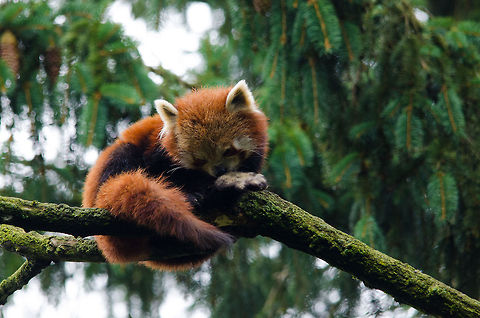
Status
The red panda is listed in CITES Appendix I. The species has been classified as vulnerable in the IUCN Red List since 2008 because the global population is estimated at about 10,000 individuals, with a decreasing population trend; only about half of the total area of potential habitat of 142,000 km2 is actually being used by the species. Due to their shy and secretive nature, and their largely nocturnal habits, observation of red pandas is difficult. Therefore, population figures in the wild are determined by population density estimates and not direct counts.Worldwide population estimates range from fewer than 2,500 individuals to between 16,000 and 20,000 individuals. In 1999, the total population in China was estimated at between 3,000 and 7,000 individuals. In 2001, the wild population in India was estimated at between 5,000 and 6,000 individuals. Estimates for Nepal indicate only a few hundred individuals. There are no records from Bhutan or Myanmar.
Reliable population numbers are hard to find, partly because other animals have been mistaken for the red panda. For instance, one report from Myanmar stated that red pandas were still fairly common in some areas, and was accompanied by a photograph of a “red panda” as proof. The photograph in question depicted a species of civet.
The red panda is protected in all range countries, and hunting is illegal.
Beyond this, conservation efforts are highly variable between countries:
⤷ China has 35 protected areas covering about 42.4% of red panda habitat.
⤷ India has 20 protected areas with known or possible red panda populations in Sikkim, Arunachal Pradesh and West Bengal such as Khangchendzonga National Park, Namdapha National Park and Singalila National Park, and a coordinated conservation policy for the red panda.
⤷ In Nepal, known populations occur in Langtang National Park, Sagarmatha National Park, Makalu Barun National Park, Rara National Park, Annapurna Conservation Area, Kanchenjunga Conservation Area, and in Dhorpatan Hunting Reserve.
⤷ Bhutan has 5 protected areas that support red panda populations.
⤷ Myanmar has 26 protected areas, of which at least one or more host red panda populations.
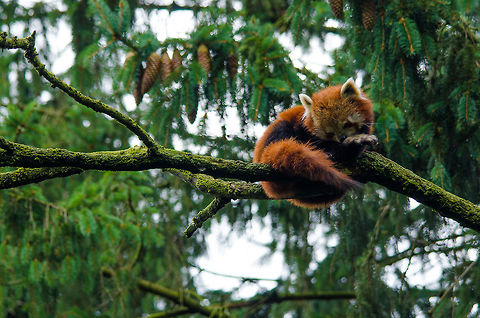
Behavior
Red pandas are territorial. Adults are solitary except during mating season. They are generally quiet except for some twittering, tweeting, and whistling communication sounds. They have been reported to be both nocturnal and crepuscular, sleeping on tree branches or in tree hollows during the day and increasing their activity in the late afternoon and early evening hours. They sleep stretched out on a branch with legs dangling when it is hot, and curled up with its tail over the face when it is cold. They are very heat sensitive, with an optimal “well-being” temperature between 17 and 25 °C , and cannot tolerate temperatures over 25 °C .Shortly after waking, red pandas clean their fur like a cat, licking their front paws and then rubbing their back, stomach and sides. They also rub their back and belly along the sides of trees or rocks. Then they patrol their territory, marking it with urine and a weak musk-smelling secretion from their anal gland. They search for food running along the ground or through the trees. Red pandas may alternately either use their forepaw to bring food to their mouth or place food directly into the mouth.
Predators of the red panda include the snow leopard, martens , and humans. If they feel threatened or sense danger, they may try to escape by climbing a rock column or tree. If they can no longer flee, they stand on their hind legs to make themselves appear larger and use the sharp claws on their front paws to defend themselves.
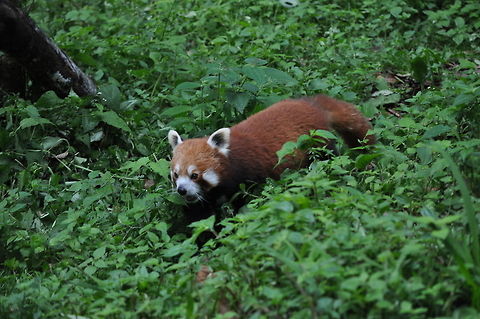
Habitat
The red panda is endemic to the temperate forests of the Himalayas, and ranges from the foothills of western Nepal to China in the east. Its easternmost limit is the Qinling Mountains of the Shaanxi Province in China. Its range includes southern Tibet, Sikkim and Assam in India, Bhutan, the northern mountains of Myanmar, and in southwestern China, in the Hengduan Mountains of Sichuan and the Gongshan Mountains in Yunnan. It may also live in southwest Tibet and northern Arunachal Pradesh, but this has not been documented. Locations with the highest density of red pandas include an area in the Himalayas that has been proposed as having been a refuge for a variety of endemic species in the Pleistocene. The distribution range of the red panda should be considered disjunct, rather than continuous. A disjunct population inhabits the Meghalaya Plateau of northeastern India.During a survey in the 1970s, signs of red pandas were found in Nepal's Dhorpatan Hunting Reserve. Their presence was confirmed in spring 2007 when four red pandas were sighted at elevations ranging from
3,220 to 3,610 m . The species' westernmost limit is in Rara National Park located farther west of the Dhorpatan Hunting Reserve. Their presence was confirmed in 2008.
The red panda lives between 2,200 and 4,800 meters altitude, inhabiting areas of moderate temperature between 10 and 25 °C / 50 and 77 °F with little annual change. It prefers mountainous mixed deciduous and conifer forests, especially with old trees and dense understories of bamboo.
The effective population size of the Sichuan population is larger and more stable than that of the Yunnan population, implying a southward expansion from Sichuan to Yunnan.
In August 2010, archaeologists uncovered red panda fossil remains in Washington County in the US state of Tennessee. Although none are known to exist in the wild in North America today, it is believed the red panda thrived in the mountains of eastern Tennessee approximately 4.5 million years ago.
The red panda has become extirpated from the Chinese provinces of Guizhou, Gansu, Shaanxi and Qinghai.

Reproduction
Red pandas are able to reproduce at around 18 months of age, and are fully mature at 2–3 years. Adults rarely interact in the wild except to mate. Both sexes may mate with more than one partner during the mating season from mid-January to early March. A few days before birth, females begin to collect material, such as brushwood, grass, and leaves, to build a nest, which is normally located in a hollow tree or a rock crevice. After a gestation period of 112 to 158 days, the female gives birth in mid-June to late July to about one to four blind and deaf cubs weighing 110 to 130 grams each.After birth, the mother cleans the cubs and can then recognize each by their smell. At first, she spends 60% to 90% of her time with the cubs. After the first week, the mother starts spending more time outside the nest, returning every few hours to nurse and groom the cubs. She moves the young frequently among several nests, all of which she keeps clean. The cubs start to open their eyes at about 18 days of age. By about 90 days, they have achieved full adult fur and coloring, and begin to venture out of the nest. They also start eating solid foods at this point, weaning at around 6–8 months of age. The cubs stay with their mother until the next litter is born in the following summer. Males rarely help raise the young, and only if they live in pairs or in small groups.
The average lifespan is 8–10 years, but individuals have been known to reach 15 years.
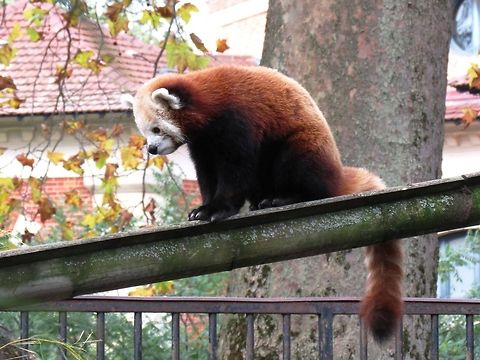
Food
Red pandas are excellent climbers, and forage largely in trees. They eat mostly bamboo, and may eat small mammals, birds, eggs, blossoms, and berries. In captivity, they were observed to eat birds, blossoms, acer and morus leaves, bark and the fruits of acer, beech and morus.Like the Giant Panda, they cannot digest cellulose, so they must consume a large volume of bamboo to survive. Their diet consists of about two-thirds bamboo, but they also eat mushrooms, roots, acorns, lichen, and grasses. Occasionally, they supplement their diet with fish and insects. They do little more than eat and sleep due to their low-calorie diet.
Bamboo shoots are more easily digested than leaves, exhibiting the highest digestibility in summer and autumn, intermediate digestibility in the spring, and lowest digestibility in the winter. These variations correlate with the nutrient contents in the bamboo. Red pandas process bamboo poorly, especially the cellulose and cell wall components. This implies that microbial digestion plays only a minor role in their digestive strategy. In order to survive on this poor-quality diet, they have to eat the high-quality sections of the bamboo plant such as the tender leaves and shoots in large quantities, over 1.5 kilograms / 3.3 pounds of fresh leaves and 4 kilograms / 8.8 pounds of fresh shoots daily. This food passes through the digestive tract fairly rapidly so as to maximize nutrient intake. Red pandas can taste artificial sweeteners such as aspartame, the only known non-primate to be able to do so.
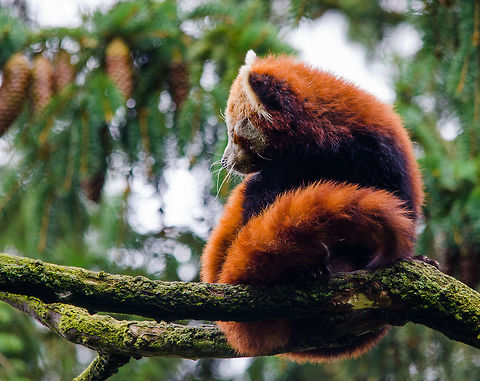
Predators
The primary threats to red pandas are direct harvest from the wild, live or dead, competition with domestic livestock resulting in habitat degradation, and deforestation resulting in habitat loss or fragmentation. The relative importance of these factors is different in each region, and is not well understood.For instance, in India the biggest threat seems to be habitat loss followed by poaching, while in China the biggest threat seems to be hunting and poaching. A 40% decrease in red panda populations has been reported in China over the last 50 years, and populations in western Himalayan areas are considered to be lower.
Deforestation can inhibit the spread of red pandas and exacerbate the natural population subdivision by topography and ecology, leading to severe fragmentation of the remaining wild population. Fewer than 40 animals in 4 separate groups share resources with humans in Nepal's Langtang National Park, where only 6% of 1,710 square kilometres is preferred red panda habitat. Although direct competition for food with domestic livestock is not significant, livestock can depress bamboo growth by trampling.
Small groups of animals with little opportunity for exchange between them face the risk of inbreeding, decreased genetic diversity, and even extinction. In addition, clearcutting for firewood or agriculture, including hillside terracing, removes old trees that provide maternal dens and decreases the ability of some species of bamboo to regenerate.
In Southwest China, red pandas are hunted for their fur, especially for the highly-valued bushy tails from which hats are produced. In these areas, the fur is often used for local cultural ceremonies, and in weddings the bridegroom traditionally carries the hide. The "good-luck charm" red panda-tail hats are also used by local newlyweds.
In the past, red pandas were captured and sold to zoos. Glatston reports that "in ''International Zoo News'', Munro reported he personally had handled 350 red pandas in seventeen years."
Thanks to CITES this number has decreased substantially in recent years, but poaching continues, and red pandas are often sold to private collectors at exorbitant prices. In some parts of Nepal and India, red pandas are kept as pets.
The red panda has a naturally low birth rate , and a high death rate in the wild.

Evolution
The red panda is considered a living fossil and only distantly related to the Giant Panda . Their common ancestor can be traced back to the Early Tertiary Period tens of millions of years ago, with a wide distribution across Eurasia. Fossils of the red panda ''Parailurus anglicus'' have been unearthed from China in the east to Britain in the west.In 1977, a single tooth of the extinct panda ''Parailurus'' was discovered in the Pliocene Ringold Formation of Washington State. This first North American record is almost identical to European specimens and indicates the immigration of this species from Asia. In 2004, a tooth from a red panda species never before recorded in North America was discovered at the Gray Fossil Site in Tennessee. The tooth dates from 4.5–7 million years ago. This species described as ''Pristinailurus bristoli'' indicates that a second, more primitive ailurine lineage inhabited North America during the Miocene. Cladistic analysis suggests that ''Parailurus'' and Ailurus are sister-taxa.
The discovery in Spain of the postcranial remains of ''Simocyon batalleri'', a Miocene relative to the red panda, supports a sister-group relationship between red pandas and giant pandas. The discovery suggests that the red panda's "false thumb" was an adaptation to arboreal locomotion — independent of the giant panda's adaptation to manipulate bamboo — one of the most dramatic cases of convergent evolution among vertebrates.The first known written record of the red panda occurs in a 13th-century Chinese scroll depicting a hunting scene between hunters and the red panda.
Major General Thomas Hardwicke’s 1821 presentation of an article titled "Description of a new Genus of the Class Mammalia, from the Himalaya Chain of Hills Between Nepaul and the Snowy Mountains" at the Linnean Society in London is usually regarded as the moment the red panda became a bona fide species in Western science. Hardwicke proposed the name "Wha" and explained: "It is frequently discovered by its loud cry or call, resembling the word ‘Wha’, often repeating the same : hence is derived one of the local names by which it is known. It is also called ''Chitwa''." Hardwicke's paper was not published until 1827, by which time Frédéric Cuvier had published his description and a figure. Hardwicke's originally proposed taxonomic name was removed from the 1827 publication of his paper with his permission, and naming credit is now given to Cuvier.
Frédéric Cuvier had received the specimen he described from his brother's stepson Alfred Duvaucel who had sent it "from the mountains north of India". He was the first who used both the binomial ''Ailurus fulgens'' and the vernacular name ''Panda'' in reference to the species in his description published in 1825 in ''Histoire Naturelle des Mammifères''. ''Ailurus'' is adopted from the ancient Greek word αἴλουρος meaning ''cat''. ''Fulgens'' is Latin for ''shining, bright''. ''Panda'' is the French name for the Roman goddess of peace and travelers, who was called upon before starting a difficult journey. Whether this is the origin of the French vernacular name ''Panda'' remains uncertain. In later publications, the name is claimed to be adopted from a Himalayan language.

Cultural
The red panda was recognized as the state animal of Sikkim, India in the early 1990s, and was the mascot of the Darjeeling Tea Festival.In southwest China red pandas are hunted for their fur, especially for the highly-valued bushy tails from which hats are produced. In these areas the fur is often used for local cultural ceremonies. In weddings the bridegroom traditionally carries the hide. The "good-luck charm" red panda-tail hats are also used by local newlyweds. This practice may be quite old, as the red panda seems to be depicted in a 13th century Chinese pen and ink scroll showing a hunting scene. There is little or no mention of the red panda in the culture and folklore of Nepal.
The Firefox browser is said to have been named after a Chinese name for red panda: 火狐, or "fire fox." However, Mozilla's documents don't mention the red panda among their motivations:
It's similar to Firebird. It's easy to remember. It sounds good. It's unique. We like it. And we weren't able to find any other project or company even remotely similar to a web browser that uses the same name.—Mozilla.org, Why change the name?
In addition, an article on its branding by the artist says that although a firefox is a red panda, the logo design is a red fox. Despite these statements, Mozilla says that Firefox is another name for Red Panda , and in 2010 the Firefox Web site started linking to a "live feed of firefox cubs" .
An anthropomorphic red panda was featured as Master Shifu, the Kung Fu teacher, in the 2008 film ''Kung Fu Panda'' and its 2011 sequel ''Kung Fu Panda 2''. Some of the comments about this film indicate the lack of awareness about the red panda in the United States when the first film was released. Although most of the reviewers got the species correct, some nevertheless mistook it for a tiny wolf, a rodent, and a lemur. In an interview, Dustin Hoffman also indicated that he did not know much about the animal when he first agreed to voice the character.
In 2005, ''Babu'', a male red panda at Birmingham Nature Centre in Birmingham, England, escaped and briefly became a media celebrity, before being recaptured. He was subsequently voted "Brummie of the Year", the first animal to receive this honor.
References:
Some text fragments are auto parsed from Wikipedia.